Final Report for OW15-019
Project Information
Throughout this two-year PDP project, we conducted five field trials with 6 collaborative farmers to evaluate insect damage on tomato, kale, zucchini, pumpkin and cucumber inside and outside of Do-it-yourself (DIY) screenhouses using 17-mesh insect exclusion nets. Four affordable DIY screenhouse designs using locally available materials were published. The participating farmers received one on one assistance from our team to install the screenhouse using affordable materials at their farms. Based on farmers’ requests, the screenhouse designs became progressively cheaper without compromising durability. Farmers’ testimonies and perception on managing insect pests using insect exclusion screenhouses are generally very positive. Along the way, the PIs recognized that the 17-mesh insect exclusion net did not exclude smaller sized soft body insects, and excluded some natural enemies, which lead to the need for integration of insecticide sprays to control soft body insects. Thus, another field trial was conducted to compare insect exclusion nets with different mesh sizes. While DIY screenhouse structures are suitable for higher value and small-scale crop production (cucumber, tomato etc), vegetable farmers that grow row crops like leafy green are complaining that all screenhouse structures are too costly for larger-scale production. They are also suffering from various caterpillar pests that are difficult to manage due to insecticide resistance. Thus, we conducted another field trial to examine insect exclusion nets as row cover without a screenhouse structure. In addition, farmers were educated on “Turn-the-Page” weed mat method for weed control, “Adopt the Insectary Plants” method to introduce beneficial insects and pollinators into the screenhouse, and “Trap Crop + biofumigation” method to manage nematode pests in the screenhouse. A total of three extension articles that have detailed procedures and prices to construct insect exclusion screenhouses or row covers were published in the University of Hawaii College of Tropical Agriculture and Human Resources (CTAHR) Sustainable and Organic Agriculture Program quarterly newsletter, Hanai’Ai, that reaches out to ~1000 readers in Hawaii including all organic farmers in the State. To use “Adopt the insectary plants” for screenhouses, two YouTube videos were produced to provide specific information on which insectary plants are appropriate to attract beneficial insects to prey on different target pests. Three public clients’ workshops were presented to statewide extension agents in Hawaii as well as farmers associations (Hawaii Farm Bureau, Hawaii Department of Agriculture, Hawaii Agriculture and Research Center, and Monsanto Hawaii). A summary of how to use oil radish as a trap crop and biofumigant against plant-parasitic nematodes for nematode management in a screenhouse is posted on the PI Website (https://gms.ctahr.hawaii.edu/gs/handler/getmedia.ashx?moid=4023&dt =3&g=12). These resources are significant for organic farmers who are seeking non-chemical approaches for various pest management.
Introduction
Due to growing environmental consciousness among consumers and growers, organic farming approaches are gaining popularity amongst vegetable farmers. However, organic farmers in Hawaii are concerned about the lack of effective, organic insect pest management tools (Radovich, 2009). Constructing screenhouses with insect exclusion nets for crop production has been practiced elsewhere and proven to reduce pesticide applications and increase crop yields compared to open field production (Romeo-Gámez et al., 2011). Purchasing fabricated screenhouses is extremely costly for farmers in Hawaii as it involves expensive shipping costs. Sugano et al. (2014) had developed protocols to construct affordable screenhouses using home improvement store supplies. Costs can be reduced for farmers if materials are procured from local hardware stores. Screening material can be sewn with UV resistant thread to meet the appropriate dimensions of the screenhouse. There is a reduced cost to farmers with materials from home improvement stores and screen material that can be sewn with UV resistant thread to get the desired width. Strong gusty winds during certain times of the year create a challenge for these structures to hold their shape and stay in place. This article modifies screenhouse designs from Sugano’s et al. (2014) publication to improve performance.
Unlike some of our U.S. mainland counter parts that had been using screenhouses or hoop houses to extend the crop-growing season into the winter, the main objective of the CTAHR screenhouse designs is for managing insect pests that are difficult to be managed with insecticides. Some pest examples include, pickle worm and melon fly on cucurbit crops, imported cabbage worm or other Lepidopteran pests on cabbage or other brassica crops, flea beetle on eggplant, rose beetle on strawberry, taro and many other crops. We used 17-mesh screen material that excludes larger size insect pests like listed above but not smaller soft body insects such as aphids, whiteflies, and thrips. Although mesh size can be substituted for a 60 mesh to exclude smaller insects, ventilation in the house will be significantly decreased and heat related stress can increase.
Unfortunately, high tunnel screenhouse crop production has several challenges. Pollination maybe compromised which is a problem for cross pollinated crops. In addition, natural enemies such as parasitic wasps, lady beetles, hoverflies, lacewings and so on will also be excluded, creating a risk of pest outbreak if the insect pests were to get in. The problem would be greater for organic producers that rely on mechanical weed management. With the screenhouse structure installed, farmers will be restricted to hand held rotovator or weed wacker which is more labor intensive than tractor driven rototillers. The difficulty of soil tillage in these structures could aggravate nematode problems. Organic farmers in Hawaii deal with plant-parasitic nematodes by growing a cover crop, sunn hemp, which produces nematode allelopathic compounds when soil incorporated. Clearly, whole-system sustainable pest management strategies need to be developed for high tunnel screenhouse production.
We are proposing to use the sequential weed mat covering approach known as “Turn the Page method” (TTP) developed by co-PI, DeFrank, who is a weed scientist. The concept is killing existing weeds or cover crops after initial weed wacking in a portion of the field by covering the soil with a light excluding tarp for 1 to 6 weeks depending on weed types and then plant cash crops with no-till. Crops are planted in the freshly uncovered areas while the tarp (or page) will be moved (or turn) to the adjacent weedy areas. Thus TTP offers a sequential weed management tactic without herbicide, tillage and avoids covering the entire screenhouse with expensive woven weed mat. Farmers can sequentially cover a quarter of the house at biweekly intervals, and plant their crop sequentially.
To address the issues of pollinators and beneficial insects being excluded by screenhouse, we propose “Adopt the Insectary” method. PI Wang had evaluated several insectary plants and developed insectary settings to attract pollinators and beneficial insects in Hawaii. Buckwheat and cilantro provide abundant pollen and nectar source for bees, hoverflies and wasps; Pigeon pea is a perennial that attracts lady beetles over a long period; Scarlet milkweed is a host for yellow aphids which are not pests for vegetable crops but are attractive to aphid parasitoids; Sunn hemp and pigeon pea attract Lycaenidae butterflies which are not vegetable pests, but draw Trichogamma wasps to parasitize their eggs; Sunn hemp also attracts alternative pollinators such as carpenter and leaf cutter bees (Wang, 2012). Installing wasps nesting blocks (Wang and Tavares, 2013) or bunched up cut bamboo sticks could serve as traps for these pollinators. Installing insectary garden adjacent the high tunnel screenhouse in the open field for one month, then flip the edge of the screenhouse to "adopt” the insectary settings into the screenhouse would attract beneficial insects inside.
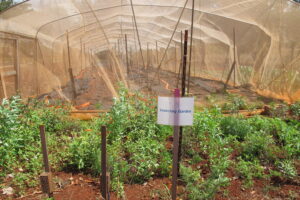
Insectary plants are planted outside of the screenhouse with a retractable screen.
Another common pest that the farmers might encountered inside a screenhouse and could not be managed through regular farming practice is plant-parasitic nematodes. We examine the potential to grow oil radish as a “Trap Crop” to trap root-knot nematodes and soil incorporate for biofumigation effect against other plant-parasitic nematodes. Oil radish is susceptible to root-knot nematodes, but if terminated within four weeks of growth, the nematode cannot fully complete its life cycle, and thus reducing the population of the nematodes in the soil prior to next crop planting. Oil radish is also a good biofumigant crop because it contains glucosinolates that can be converted into isothiocyanates upon contact by myrosinase in the damaged tissues. Isothiocyanates and other by-products of glucosinolate hydrolysis include sulfate ions are toxic to plant-parasitic nematodes. Biofumigation performed by oil radish residues following their trap cropping effect are effective ways to manage plant-parasitic nematodes as the nematodes are more vulnerable to biofumigation during their active stage when a susceptible host is present as oppose to when nematodes are in their survival stage in the absence of a host (Williams and Weil, 2004).
Specific objectives of this proposed project are to:
- Compare crop yields and market values of produce from screenhouse (SH) vs open field (OF) production of each farmers.
- Monitor insect pest damage (pickleworms and fruit flies for squash, incidence of virus on tomato, flea beetle damage on eggplant, rose beetles on taro, imported cabbage worm or diamond back moth damage on lettuce), weed pressure, and nematode population densities in SH vs OF production.
- Evaluate the suppression of root-knot nematode population densities following “Dead-end Trap Crop” practice.
- Scout for diversity of beneficial insects visiting cash crops in SH vs OF production.
- Conduct workshops and field day events for “Do-it-yourself (DIY) screenhouse construction”, “Turn-the-Page”, “Adopt the Insectary plants” and “Dead-end Trap Crop” methods and evaluate farmers’ perception, adoption, and record their suggestions/inputs on the project. These workshops will be repeated for the University of Hawaii new farmers training program, GoFarm Hawaii, as part of their on-farm training lectures.
Cooperators
Research
Objective 1, 2, & 5: We conducted a series of field trials with 6 collaborative farmers to evaluate insect damage on tomato, kale, zucchini, pumpkin and cucumber inside and outside of Do-it-yourself (DIY) screenhouses using 17-mesh insect exclusion nets. We published extension and outreach materials with information related to: “Do-it-yourself (DIY) screenhouse construction”, “Turn the Page” weed management, “Adopt the Insectary plant” to the screenhouse, and “Dead-end Trap Crop” and “Biofumigation” methods for nematode control inside a screenhouse. Besides evaluating the benefits of screenhouse production for managing various hard to manage arthropod pests using 17-mesh screen materials, we also extended our project to evaluate other screen materials with finer mesh size for insect pest exclusion.
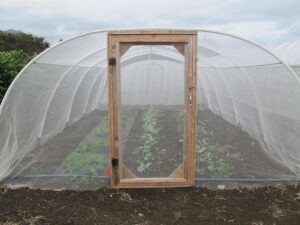
CTAHR DIY Hoop House design
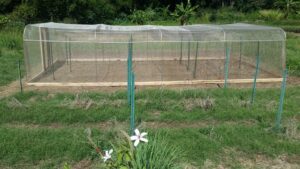
CTAHR DIY Screenhouse with wood based/E-Z corner design. 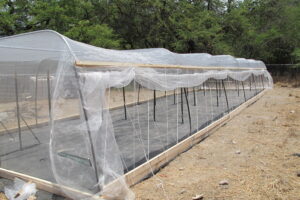
CTAHR DIY Screenhouse with wood based/E-Z corner and retractable wall.
A series of field trials were conducted inside and outside of Do-It-Yourself (DIY) screenhouses using 17-mesh insect exclusion net that we had assisted 5 farmers to construct. Four designs are posted in Hanai’Ai newsletter published by CTAHR Sustainable and Organic Agriculture Program, https://gms.ctahr.hawaii.edu/gs/handler/getmedia.ashx?moid=2875&dt=3&g=12. So far all the sreenhouses have withstood the gusty winds occasionally encountered. A report was summarized and presented to state wide extension agents and local farmers at the Sustainable and Organic Agriculture Program’s Extension and Research Update event which took place at the Waimanalo Experiment Station on November 9, 2016. More than 60 people attended the event, mostly extension agents throughout the state of Hawaii. The data is summarized and posted at http://www.ctahr.hawaii.edu/WangKH/Downloads/2016_Organic_SPM.pdf. A second field day mainly targeting new farmers in Hawaii was hosted on Jan 28, 2017 where PI Wang summarized all screenhouse trials in “Managing insects and weeds in DIY screenhouses” (https://gms.ctahr.hawaii.edu/gs/handler/getmedia.ashx?moid=4854&dt=3&g=12).
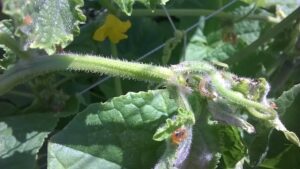
Pickle worms bore inside cucumber stems when grown outside of the screenhouse.
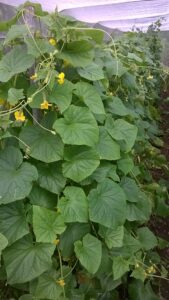 Cucumber grown inside the screenhouse.
Cucumber grown inside the screenhouse.
The screenhouse prices range from $0.68 to $0.95 per sq ft., which is equivalent to $510 to $713 for a 15’ × 50’ × 6’ house. However, increasing numbers of small-acreage farms in Hawaii earning less than $10,000 a year (NASS, 2014) are asking for cheaper and more stable screenhouse designs for insect pest management. Thus, PIs from this project designed and constructed another screenhouse, the hoop house design. Although it costs $0.78/ft2, it is more stable than the $0.68/ft2 hoop house. Another challenge from the $0.95/ ft2 design was that although it can block larger insect pests, it allows the entrance of smaller insect pests such as aphids, whiteflies and thrips. Therefore, we conducted another experiment to compare prices and insect pest management effects of screenhouses using different mesh sizes (17, 40 and 75 mesh, 30% reflective shade). The results are summarized and published in Haina’Ai (https://gms.ctahr.hawaii.edu/gs/handler/getmedia.ashx?moid=2972&dt=3&g=12).
Comparing mesh sizes: Zucchini yield from this trial clearly demonstrated that all the insect exclusion screens (17, 40 and 75) protected zucchini fruit from the key pests of zucchini i.e. pickleworms and melon flies. These different mesh sizes had resulted in higher marketable yield in the hoop houses than the open field (OF). We also compared insect exclusion screens with a reflective shade material. This shade material is more readily available from local agricultural distributors in Hawaii than the 17-mesh screen. It’s reflective properties allow it to initially repel some whiteflies. However, the mesh size is 2 times larger than the 17-mesh. Eventually whiteflies, thrips and aphids got in the house. Thus it is not a good alternative to insect exclusion nets if the grower’s interest is to protect the crop from insect pests. On the other hand, finer screen materials (40- and 75-mesh) that cost more than the 17-mesh, did not protect the crop from aphids but did slow down and reduce whiteflies and powdery mildew damage. High counts of aphids in 40-mesh could be due to cross contamination from researchers moving between screenhouses. While the effect of 40-mesh on aphid infestation needs further evaluation, it is important to pay attention to sanitation working inside and outside of a screenhouse. 40-mesh screen is 2.8 times and 75-mesh screen is 6.8 times more expensive than the standard 17-mesh screen. Yet marketable yield of zucchini in this trial is better in 17 mesh than those in 40- and 75-mesh. However, a previous kale trial conducted in a 17-mesh screenhouse resulted in an outbreak of thrips inside the screenhouse (Ching et al., 2016). Thus, effects of screen materials are pending on insect pests present. In addition, since the insect infestation inside the 17-mesh screenhouse was low, a weekly insecticide spray rotation did not further protect the crops from aphids or whitefly damage in this trial.
Overall, this zucchini trial demonstrated that a hoop house design with the 17-mesh screen is a worthwhile investment for farmers. Previous screenhouse design using EZ corners and lumber for the structure cost $0.95/ft2. The current hoop house design using a 17-mesh screen costs $0.78/ft2. Although insect exclusion screens reduced light intensity compared to open field, zucchini growth and health was not compromised and in fact was stimulated in the 40-mesh hoop house. Plants in the 75-mesh house did show signs of elongated growth later in the season. However, reduction in light intensity in all the screenhouses resulted in more blossom end rot. None-the-less, blossom end rot did not contribute to major yield reduction.
Row cover: In the event that farmers prefer to grow crops in open fields in relatively larger scale, but would like to cover just the planting row with insect exclusion net without having to construct screenhouse structure, Co-PI Sugano conducted another trial to evaluate effects of Proteknet “Biothrips” Insect Netting (Johnny Seed) as row cover with Enviromesh 17-mesh screen with hoops, and pesticide sprays against cabbage webworm (Hellula undalis). The 17-mesh screen with hoops reduced cabbage webworm as effectively as the commercial pesticide Coragen. Proteknet “Biothrips” Insect netting without the hoop structure costs only $0.15/ft2 but did not reduce webworm damage partly due to its light weight and inability to withstand wind. Other OMRI certified organic insecticides tested in this trial included Pyganic, Debug Turbo, Crymax, and Entrust, among which only Entrust suppressed cabbage webworms comparable to Coragen, a synthetic insecticide, and the 17-mesh screen.
Objective 3, 5. Graduate student, Waisen, examined the effects of oil radish for plant-parasitic nematode management and determined that ‘Sod Buster’ oil radish (Raphanus sativus) can serve moderately effective as a trap crop to trap root-knot nematodes if terminated 1 month after planting. However, the oil radish terminated by tillage did not suppressed root-knot nematodes effectively compared to the control. The student then modified the experiment and focused on improving the cover crop termination method to enhance the biofumigation effect of oil radish by covering the soil with black plastic to contain the biofumigant for one week. The black plastic was then removed prior to crop planting. The results were very promising. Not only did it suppress plant-parasitic nematodes significantly throughout a zucchini crop, but it also enhanced bacteria-feeding nematode populations in the soil, increased nutrient cycling and resulted in better zucchini yield. The student presented the results at the CTAHR Student Research Symposium.
Objective 4. To “Adopt the insectary plants” to the screenhouse, two YouTube videos were produced to provide specific information on which insectary plants are appropriate to attract beneficial insects to prey on different target pests. We also designed a screenhouse with open wall that can allow the farmer to open the screen during the day time to attract pollinators and other beneficial insects (natural enemies), and close the screen at night to prevent the nocturnal insect pests from getting in. One side of the screenhouse wall can be opened when the targeted pest population is not a risk (pickle worms are more active at night, thus, the screenhouse can be open during the day time especially when pollination is needed at the cucumber flowering stage). This approach allows farmers to not have to rely on seeds of parthenocarpic varieties, which are very expensive. Alternatively, farmers could also plant insectary plants like buckwheat inside the screenhouse to practice the “Adopt the insectary plants” method by opening one side of the screenhouse wall. This approach allows beneficial insects to prey on smaller insect pests inside the screenhouse. Pumpkin grown in this screenhouse with insectary plants had minimal pickle worm damage, and an acceptable yield.
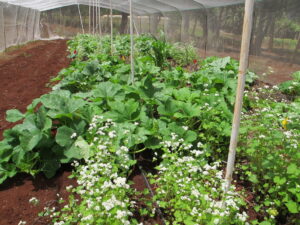
Buckwheat as insectary plants to host beneficial insects like hover flies inside the screenhouse.
Objective 5. “Turn-the-page” (TTP) weed management strategy is a novel weed management strategy initiated by co-PI Defrank. Basically, the concept is killing existing weeds or cover crops after initial weed trimming in a portion of the field by covering the soil with a light excluding weed mat for 1 to 6 weeks depending on weed types and then plant cash crops. This is compatible with a no-till cropping system, thus farmers have no need to use a tiller inside a screenhouse. Crops are planted in the freshly uncovered areas while the weed mat (or page) will be moved (or turn) to the adjacent weedy areas. Thus TTP offers a sequential weed management tactic without herbicide, tillage and avoids covering the entire screenhouse with expensive woven weed mat. Three field trials conducted to examine the efficacy of TTP method for weed control revealed that a minimum of 3 weeks coverage in combination with irrigated weed flushing suppressed grasses and broadleaf weeds effectively. However, this weed management technique is mostly suitable for transplanted rather than direct seeded crops. Another experiment was conducted within the screenhouse using the TTP method to control weeds compared to an herbicide treatment. Weeds were flushed for 3 or 6 weeks prior to each treatment. Zucchini was planted and weeds were evaluated. The TTP method with 3 weeks of weed flushing had less weeds than the herbicide treatment. The TTP method with 6 weeks of weed flushing had more weeds than the herbicide plots. Thus, 3 weeks of weed flushing is recommended for TTP weed management.
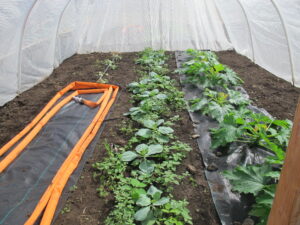
"Turn-the-page" (TTP) weed management using weed mat and water hose to cover and kill weeds.
Overall for Objective 5, we generated 3 extension publications and 4 videos. Posters and oral presentations were given at national and international conferences. Field days and workshops were conducted throughout this project with positive responses from farmers and participants. The collaborating farmers were happy with the screenhouses and gave positive comments on their higher marketable yield from the screenhouses.
All results and discussion of results from our experiments are published in the articles attached.
DIYScreenhouseReviewII-Nov2016
Organic-Insecticide-Cabbage-Webworm-Trial-with-Daikon01202017
All farmer collaborators worked with PIs to construct a screenhouse in their farm.
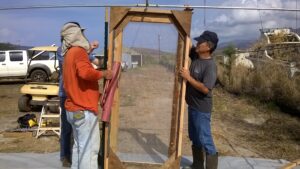
Dan Ching helped to construct two screenhouses in Waianae.
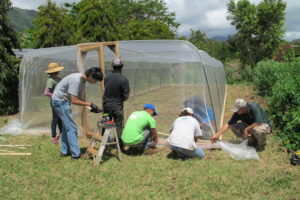
Students worked with CTAHR extension agents to install a screenhouse iat Waimanalo for GoFarm Hawaii, a new farmers training program.
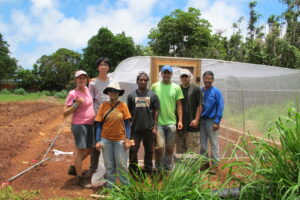
Mele Judd on the far left with CTAHR team constructed the screenhouse and she grew zucchini and pumpkin inside and outside of the screenhouse for comparison. 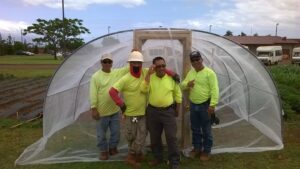
Monsanto Hawaii farm crew adopt the hoop house design and installed it at Kunia.
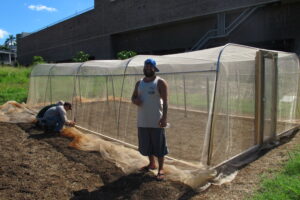
Anthony Deluze worked with co-PI Uyeda to construct a screenhouse in Pearl City.
Research outcomes
Education and Outreach
Participation summary:
Extension publication
Wang, K.-H., J. Sugano, S. Fukuda, J. Uyeda, D. Meyer, and S. Ching. 2017. DIY Screenhouse for insect management in the Tropics: Part I. HānaiʻAi Newsletter 28: Dec, Jan, Feb 2017. https://cms.ctahr.hawaii.edu/soap/HanaiAi.aspx
Wang, K.-H., J. Sugano, S. Fukuda, S. Ching, J. Kam, J. Uyeda, and D. Meyer. 2017. DIY Screenhouse for insect management in the Tropics: Part II Hoop Houses. HānaiʻAi Newsletter 28: Dec, Jan, Feb 2017. https://cms.ctahr.hawaii.edu/soap/HanaiAi.aspx
Kylie Wong1, Josh Silva1, Robin Shimabuku2, Steve Fukuda1, Jari Sugano2, Koon Hui Wang2, Jensen Uyeda1, Fred Reppun1, Shelby Ching2, Jonathan Kam2 and Ronald Mau2. Comparing Physical Barriers and Organic Pesticides for Controlling Cabbage Webworm on Daikon. HānaiʻAi Newsletter 28: Dec, Jan, Feb 2017. https://cms.ctahr.hawaii.edu/soap/HanaiAi.aspx.
Videos
- Wang, K.-H., S. Ching and J. Uyeda. 2016. Insectary settings for arthropod pest Part I and Part II. Hānai‘Ai Newsletter September, October, November, 2016. http://go.hawaii.edu/82j or at (https://youtu.be/BsN_3lC35wg and https://youtu.be/1stOru5I-a0).
- Screenhouse with retractable wall to adopt beneficials (produced by Jensen Uyeda)
https://www.youtube.com/watch?v=cBP52egYG9s - Screenhouse production with PVC Hoops (produced by Jensen Uyeda)
https://www.youtube.com/watch?v=EU5uFxW98Ng
Refereed Conference presentation/Published abstracts:
- Waisen, P., K.-H. Wang, Z. Cheng, J. DeFrank, J. Leary, and B.S. Sipes. 2017. Will enhancement of biofumigation effect of brassica cover crops against plant-parasitic nematodes compromise their soil health promoting effect? CTAHR Student Research Symposium Honolulu, HI. April 8, 2017 (Abstract #107) (1st Place PEPS PHD Oral Presentation).
- Waisen, P., -H. Wang, Z. Cheng and B. S. Sipes. 2016. Developing effective management strategies against plant-parasitic nematodes using oil radish in Hawaii. Society of Nematologists/Organization of Nematologists in Tropical Agriculture, Montreal, Canada. July 18-22, 2016.
- Domen, B. and -H. Wang. Turn-the-page weed mat covering for weed management in a no-till cropping system. CTAHR Student Research Symposium, Honolulu, HI. April 8, 2016.
- Waisen, P. and -H. Wang. Screening oil radish (Raphanus sativus) varieties for nematode management through trap cropping and biofumigation effects. CTAHR Student Research Symposium, Honolulu, HI. April 8, 2016.
Field days and Workshops
- Waisen, P., K.-H. Wang, and B. Sipes. 2017. Field Demonstration for cover crop management of plant-parasitic nematodes. Cover Crop Calculator Workshop, Poamoho Experiment Station, March 16, 2017 (attendance: 22)
- Waisen, P. and K.-H. Wang. 2017. Managing Plant-Parasitic Nematodes using Organic Farming Approaches. Conservation Agriculture Field Day, Poamoho Experiment Station, February 4, 2017 (attendance: 12).
- Wang, K.-H., S. Ching, J. Kam, J. Sugano, S. Fukuda, J. Uyeda, and D. Meyer. 2017. Managing Insects and Weeds in DIY Screenhouses. Screenhouse and Pest Management Field Day, Waimanalo Experiment Station, January 28, 2017 (attendance: 45).
- Ching, S.A., K.-H. Wang, J. Sugano, S. Fukuda, J. Uyeda, D. Meyer, J. Kam. 2016. Screenhouse for tomato, brassica and cucurbit crop productions. Sustainable and Organic Agriculture Program’s Extension and Research Update, Waimanalo Experiment Station, November 9, 2016 (attendance 60) http://www.ctahr.hawaii.edu/WangKH/Downloads/Screenhouse_insects_management.pdf
- Waisen, P., K.-H. Wang, J. Sugano, J. Uyeda, J. DeFrank. 2016. Managing plant-parasitic nematodes using trap cropping and biofumigation. Sustainable and Organic Agriculture Program’s Extension and Research Update, Waimanalo Experiment Station, November 9, 2016 (attendance 60) http://www.ctahr.hawaii.edu/WangKH/Downloads/PWaisen_Waimanalo_2016.pdf
- Sugano, J., K.-H. Wang, J. Uyeda, S. Fukuda, S. Ching, J. Kam. Screening to exclude agricultural pests. Vegucation Farmer Workshop: Farmers Field Day Experience. Hawaii Farm Bureau, HDOA, HARC, Monsanto Hawaii, Kunia, HI. Sept 14, 2016 (attendance 100).
- Wang, K.-H, J. Sugano, J. Uyeda, S. Ching, J. Kam, T. Radovich, S. Fukuda. Organic and sustainable pest management options. Advancing Oahu’s Edible Crop Industries-Mini Conference. Turtle Bay Resort Turtle Bay, HI. May 24, 2016. (Attendance: 120).
- Wang, K.-H. Cover crop and pest management. GoFarm Hawaii at Windward Community College, April 20, 2016. (12 students).
- Wang, K.-H. Cover crop and pest management: Lecture and field scouting. GoFarm Hawaii at Leeward Community College, Feb 27, 2016. 12 students.
- Wang, K.-H., J. Uyeda, S. Migita, J. Marquez, Philip Waisen, G. Nagai, S. Mishra. AgExposure: Working at Poamoho Experiment Station, GoFarm Hawaii at Leeward Community College (LCC), December 5, 2015, 20 students. http://www.gofarmhawaii.org/blog/agxposure-at-ctahr-poamoho.
Education and Outreach Outcomes
Areas needing additional study
- Due to lack of natural enemies in the screenhouse, small arthropod pests that can move through the mesh can also cause an outbreak inside the screenhouse.
- Cucurbit and many fruit crops require pollination to set fruits. Parthenocarpic seeds are usually expensive.
- Although kale in the screenhouse was not damaged by caterpillars, thrips damage was more severe inside the screenhouse than outside.
Thus additional studies are needed to resolve this problems for screenhouse crop production.